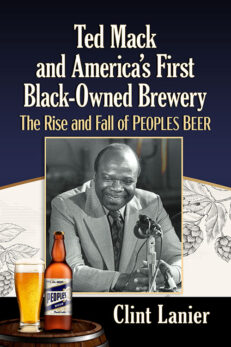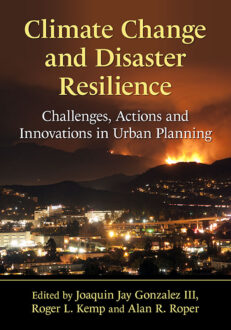Climate Change and Disaster Resilience
Challenges, Actions and Innovations in Urban Planning
$39.95
In stock
About the Book
Climate change and natural disasters have always been hot topics of discussion and debate from the living rooms of citizens to meetings to civil society organizations’ candlelight vigils. The consensus from the scientific and academic community on the threat of climate change clashes with the lack of consensus from business and government leaders, while citizens question the scientific data on climate change and if it really affects their cities. Many cities have stepped up to provide united experience-backed testimonies explaining this threat and how climate change contributes to natural disasters, habitat destruction, and food shortage. This book brings together lucid essays and case studies from both scholars and individuals on the front lines who manage international collaborations, lead local communities, provide services for people impacted by disasters, and drive policy change that will lead to a sustainable future. Instructors considering this book for use in a course may request an examination copy here.
About the Author(s)
Bibliographic Details
Edited by Joaquin Jay Gonzalez III, Roger L. Kemp and Alan R. Roper
Format: softcover (7 x 10)
Pages: 283
Bibliographic Info: glossary, appendices, notes, index
Copyright Date: 2022
pISBN: 978-1-4766-8243-3
eISBN: 978-1-4766-4297-0
Imprint: McFarland
Table of Contents
Acknowledgments vi
Preface 1
Part I. Introduction
1. Climate Change
U.S. Geological Survey 5
2. Climate Change: How Do We Know?
National Aeronautics and Space Administration 9
3. Scientific Consensus: Earth’s Climate Is Warming
National Aeronautics and Space Administration 12
4. As the Trump Administration Retreats on Climate Change, U.S. Cities Are Moving Forward
Katherine Levine Einstein, David Glick and Maxwell Palmer 15
5. A Whole-of-Government Approach: Embedding Disaster Resilience
Patrick Howell 18
6. Designing Greener Streets Starts with Finding Room for Bicycles and Trees
Anne Lusk 21
7. Climate Change Resilience Could Save Trillions in the Long Run
David L. Levy 24
8. Measuring Up U.S. Infrastructure Against Other Countries
Hiba Baroud 27
Part II. Challenges
9. The Causes of Climate Change
National Aeronautics and Space Administration 33
10. Effects of Climate Change
National Aeronautics and Space Administration 36
11. Climate Change Threatens Drinking Water Quality Across the Great Lakes
Gabriel Filippelli and Joseph D. Ortiz 40
12. Long-Term Disaster Recovery
C.H. “Burt” Mills, Jr., and William R. Whitson 43
13. Rethinking the “Infrastructure” Discussion Amid a Blitz of Hurricanes
Andrew Revkin 48
14. Cap and Trade Is Supposed to Solve Climate Change, but Oil and Gas Company Emissions Are Up
Lisa Song 53
15. Endangered Species Under GOP? Climate Change Information on the Web
Andrew Revkin 61
16. California Fires Illuminate Trauma and Resilience
Anna Maria Barry-Jester 64
17. How to Zero In on Your Final, Forever Home While Skirting Disaster
Janice Lloyd 67
18. Hurricane Maria’s Legacy: Thousands of Puerto Rican Students Show PTSD Symptoms
Carmen Heredia Rodriguez 69
Part III. Actions and Innovations
• A. Citizens and Public-Private Partnerships •
19. Both Conservatives and Liberals Want a Green Energy Future, but for Different Reasons
Deidra Miniard, Joe Kantenbacher and Shahzeen Attari 73
20. Volunteering During a Disaster
Benjamin Paley 76
21. From Pledges to Action: Cities Need to Show Their Climate Progress with Hard Data
Conor K. Gately and Lucy Hutyra 78
22. Becoming Crisis Ready
Melissa Agnes 81
23. Top Five Tips for Planning, Preparing and Adapting to Climate Change
Niles Anderegg 85
24. Seven Strategies for Managing Uncertainty
Nicole Lance 88
25. The Role of Education in Environmental Activism
Alan R. Roper 91
26. The University of California’s Carbon Neutrality Initiative
Alan R. Roper 97
27. Role of Mobile Apps in Public Administration of Disaster Relief
Peter Lyn René 102
• B. Cities •
28. Meeting Climate and Energy Action Plan Goals in Ashland, Oregon
Talia Shea and Alan R. Roper 104
29. The Future of Napa County Environmental Impact Decisions
Melissa Diede 112
30. San Rafael Climate Change Action Plan: An Excerpt
City of San Rafael 117
31. Building Climate Resilience in Cities: Lessons from New York
Cynthia Rosenzweig and William Solecki 121
32. Eye on Climate Change
International City/County Management Association 125
33. Local Government Climate Change and Evolution
Minch Lewis 130
• C. States and the Feds •
34. California’s Capabilities to House Disaster Survivors
Melynda Moran and Alan R. Roper 133
35. How Texas Is “building back better” from Hurricane Harvey
Nicole Errett 140
36. Climate Change: Basic Information
Environmental Protection Agency 143
37. Impacts, Risks and Adaptation in the United States
U.S. Global Change Research Program 148
38. Climate Change Adaptation
U.S. Department of Agriculture 155
39. Climate Research
National Oceanic and Atmospheric Administration 158
40. Greenland’s Rapid Melt Will Mean More Flooding
Arielle Samuelson 162
41. Ice in Motion: Satellites Capture Decades of Change
Kate Ramsayer 164
• D. International •
42. Fighting Climate Change
Sadhu Aufochs Johnston 166
43. Cities and Climate Change
United Nations Environment Programme 170
44. Mapping Mangrove Management: Lessons Learned from Mexico
Astrid J. Hsu 174
45. A Case for Transition Shelters
Gabby V. Moraleda 181
46. Incentivizing Collaborative Governance for Climate and Disaster Adaptation
Maria Fe Villamejor-Mendoza and Joaquin Jay Gonzalez III 186
47. Climate Change Justice and Environmental Litigation in the Philippines
Alder K. Delloro and Joaquin Jay Gonzalez III 194
48. Fostering Resilience in Water Supply Management
Jake Rom D. Cadag, Sergio Andal, Jr., Evelyn Sagun and Julie-Ann Ross Deus 201
49. Bridging the Gaps: Disaster Risk Reduction, Climate Change Adaptation and Development Planning
Jake Rom D. Cadag, Sergio Andal, Jr., and Julie-Ann Ross Deus 209
50. Trump’s Defense Secretary Cites Climate Change as National Security Challenge
Andrew Revkin 217
Part IV. The Future
51. Build Disaster-Proof Homes Before Storms Strike, Not Afterward
T. Reed Miller 223
52. Extreme Weather News May Not Change Climate Change
Skeptics’ Minds
Ryan Weber 226
53. We Can’t Save Everything from Climate Change
Benjamin Preston and Johanna Nalau 229
54. Impact of Natural Disasters and Other Emergencies on Global Supply Chains
Paul H. Jennings 232
55. Alternative Facts Are the Enemy of Health Security and Resilience
Nathan Myers 234
Appendices
Appendix A: Glossary and Acronyms of Climate Change and Disaster Resilience
Joaquin Jay Gonzalez III and Alan R. Roper 239
Appendix B: United Nations Paris Agreement (2015) 247
Appendix C: FEMA Climate Change Adaptation Policy Statement (2011-OPPA-01)
Federal Emergency Management Agency 262
About the Contributors 265
Index 269
Book Reviews & Awards
“A collection of essays in four parts presenting the scientific foundations for understanding both climate change and its consequences. …the book warns that climate change denial and ‘alternate facts’ have long-term consequences. …a solid, accessible source that synthesizes current knowledge…recommended”Choice





